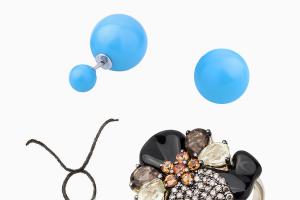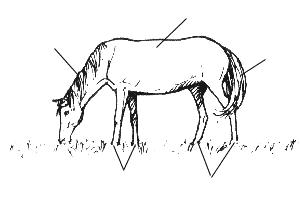We are accustomed to the fact that in the fall the leaves turn yellow and the trees shed them until spring. We admire the yellow foliage, we admire the romanticism of autumn, but we don’t know why the leaves turn yellow. And it turns out there is a scientific explanation for this.
For many years, scientists have studied leaves and how they change color in the fall. Molecules responsible for bright shades yellow and orange are no longer a mystery, but why the leaves turn red still remains a mystery.


Reacting to change in air temperature and less daylight, leaves stop producing chlorophyll(which gives green color), absorbs blue and partially red light emitted by the Sun.Since chlorophyll is sensitive to cold, some changes in weather, such as early frosts, will “switch off” its production faster than usual.

At this time, orange and yellow pigments called carotenoids(which can also be found in carrots) and xanthophylls shine through leaves that have no green left. “The yellow color is present in the leaves all summer, but it is not visible until the green disappears,” says Paul Schaberg

“The yellow color is present in the leaves all summer, but it is not visible until the green disappears,” says Paul Schaberg(Paul Schaberg), plant physiologist with the US Forest Service. But scientists don't yet have much information about the red color that appears on some leaves in the fall. It is known that the color red comes from anthocyanides, which, unlike carotenoids, are produced only in the fall. Anthocyanidins also provide color to strawberries, red apples and plums.
Trees produce anthocyanidins when they sense a change in the environment - frost, ultraviolet radiation, drought and/or fungus. But red leaves are also a sign of illness tree. If you notice that the leaves of a tree have turned red earlier than usual (at the end of August), most likely the tree is suffering from a fungus, or it has been damaged somewhere by humans.
Why does a tree waste its energy to produce
new anthocyanidins in a leaf when that leaf is about to fall off?
Paul Schaberg believes that if anthocyanidins help leaves stay on the tree longer, they may help the tree absorb more useful substances before the leaves fall. The tree can use the absorbed resources to bloom the next season.
Anthocyanins
The topic of anthocyanins is a little more difficult to study than other components of trees. Although all trees contain chlorophyll, carotene and xanthophylls, not all produce anthocyanins. Even those trees that have anthocyanins produce them only under certain conditions. Before a tree gets rid of its leaves, it tries to absorb as much more nutrients from the leaves, at which point anthocyanin comes into play.

Scientists have several answers to the question of why some trees produce this substance and their leaves change color.
The most common theory suggests that anthocyanins protect leaves from excess sunlight, while allowing the tree to absorb beneficial substances stored in the leaves.These pigments are on the tree play a role sunscreen , blocking dangerous radiation and protecting leaves from excess light. They also protect cells from rapid freezing. Their benefits can be compared to those of antioxidants.
Lots of sunshine, dry weather, frosty weather, low level nutrients and other stress factors increases the sugar concentration in tree sap. This triggers the production of large amounts of anthocyanins in a last-ditch attempt to store energy to survive the winter.
Scientists believe that studying anthocyanidins will help to understand the level of illness every tree. This, in turn, will provide a clearer picture of environmental issues in the future.As a book and cartoon character said Lorax: "The color of the trees will one day be able to tell us what it feels like... this moment tree".
DID YOU KNOW...
WHY DO THE LEAVES TURN YELLOW? Green color The leaves are given a special substance - chlorophyll. Chlorophyll in a living leaf is constantly destroyed and re-formed. But this only happens in the light.
In summer the sun shines for a long time. Chlorophyll is destroyed and immediately restored. Therefore, the leaf remains green all the time.
Yellow paint is always in the leaves. Only in summer yellow unnoticed. It becomes clogged with a stronger one - green.
Autumn is coming, the nights are lengthening. Plants receive less light. Chlorophyll is destroyed and does not have time to recover. The green color in the leaf decreases, and yellow becomes noticeable - the leaf turns yellow.
The foliage falls green from the alder and lilac trees. Their leaves contain no other coloring substances other than chlorophyll.
According to G. Graubin
WHY ARE THE LEAVES ON ONE ASPEN YELLOW, AND ON THE OTHER ARE RED?
It turns out that the substance that gives the leaves their red color is formed in those plants that have stored more sugar. Plants that failed to do this have yellow leaves.
WHY DO THE LEAVES FLIP FROM THE PLANTS?
In the winter cold, plant roots are almost unable to get water from the ground.
In autumn there is a lot of water, but it is cold. Therefore, plant roots cannot absorb it.
Leaves continuously evaporate water. So the plants have to shed them so as not to dry out in winter.
In winter, the leaves would only damage the plant. Piles of snow falling on them would break branches and twigs. In addition, they accumulate in the leaves during spring and summer. harmful substances. By shedding leaves, the plant is cleared of them.
How does spruce get rid of unnecessary substances?
It turns out that spruce leaves are also falling. But its leaves do not fall all at once, but little by little and constantly. New ones grow in their place. Some fall, others grow. This happens unnoticed by our eyes, and it seems to us that the spruce always has the same leaves-needles.
WHY DOESN'T THE SPRUCE LOSE LEAVES FOR THE WINTER?
The needle leaves of the spruce were small, hard, and resinous. They evaporate less water than ordinary leaves. Winter drought is not scary for spruce.
Why don't tree branches break off under the weight of snow? Because they grow obliquely downwards and spring. Snow easily slides off the branches from the slightest push, blowing wind, or from the excessive weight of wet snow. In addition, due to the waxy coating of the needles, the snow does not stick to them firmly.
WHY ARE THERE NO WOUNDS ON THE BRANCHES FROM FALLEN LEAVES?
The thing is that the leaves do not break off the branches, but fall in a strictly defined place - where the petiole is attached.
In summer, the petioles of the leaves are firmly connected to the branches. In autumn, amazing changes occur in the petioles.
In the place where the petiole is attached to the branch, a special cork layer gradually grows. It, like a partition, separates the petiole from the branch.
Now the leaf and branch are connected by several thin fibers. The weight of the leaf itself, the impact of a drop of rain, or a blow of wind is enough for the leaf to easily separate from the plant.
LEAF FALL
The earliest trees to lose their leaves are linden, birch and elm.
In linden and poplar, the leaves of the large lower branches fall off first, then the middle is exposed, and the top of the tree flies last. But in elm, hazel, and ash, leaf fall begins from the upper branches. The foliage gradually melts, revealing dark trunk tree.
With the first frosts, aspen leaves fall off, then maple leaves. Only the alder and willow trees along the river banks stand thick and green until the first snow. And then the frozen, blackened, crispy leaves fall off.
According to V. Korabelnikov
Probably everyone admires the colorful leaves in autumn. It’s so beautiful to watch how the leaves change their color and how slowly they fall to the ground. The colors of autumn have been sung more than once by poets and writers, and it is not for nothing that they say “the charm of the eyes” about autumn. However, few people have thought about the question, but Why do the leaves on trees turn yellow and fall off in the fall?? What causes them to suddenly change color from deep green to bright yellow, purple, brown or orange?
Chlorophyll tends to be produced only when sunlight. After all, the process is the absorption of carbon dioxide from the air, and water from the root system located underground. This absorption process can be called exchange, since during it photosynthesis also occurs, since the leaves, in turn, begin to produce the purest oxygen. It’s not for nothing that trees are called “the green lungs of planet Earth.”
Why do leaves on trees turn yellow in autumn?
If we talk about autumn, then it represents a time of rest for nature and for trees, in particular. After all, just recently they delighted us with a variety of greenery. Now it’s time for them to prepare for winter sleep, during which the trees will accumulate strength for spring and summer blossoming.
With the arrival of autumn, the length of daylight hours decreases. Consequently, the process of photosynthesis also does not have enough time to develop. The process of photosynthesis is important for trees to obtain food. So it turns out that the tree receives less and less nutrients, which entails a slowdown in all processes.
Chlorophyll begins to break down, and less and less green color is visible in the leaves. Now comes the turn of other color pigments: yellow xanthophyll, orange carotene and red anthocyanin. Thanks to these pigments, the leaves acquire such bright colors.
Probably everyone has noticed that not all trees “dress” the same in the fall. Some colors are dominated by crimson tones, some are yellow, and some are brown. For example, the leaves of maples and aspens turn purple. The leaves of linden, oak and birch trees are cast in gold. It is interesting that the leaves of alder and lilac do not have time to change color; they fall off while still green. Why? Yes, because the leaves of these trees do not contain any coloring pigments other than chlorophyll.
All life processes in trees slow down with the arrival of autumn, life force leaves are fading. And this process is eternal, like life itself, and just as natural and irreversible. That is, those leaves that have already lost their green pigment chlorophyll will no longer be able to regain their strength.
The leaf coloring process can be divided into three stages:
- Beginning of leaf color change. Some leaves are turning yellow;
- Change in color of tree crowns. The tops begin to become variegated and noticeably different from the rest of the crown;
- Complete change in leaf color. Almost the entire crown has changed its color.
The falling of leaves is the release of all harmful substances. Accumulates in leaves a large number of nutrients. However, in addition to beneficial substances, harmful substances also accumulate in the leaves - metabolites, excess mineral salts, which only harm the health of the tree. Autumn is the time when the tree begins to get rid of the harmful leaves contained in it, and leaves the useful ones for the winter.
In addition, scientists have proven that in winter, when there are no leaves on the crown, the tree has little chance of suffering from drought. The reason is that the leaves take up a lot of moisture, and the roots cannot cope with its lack.
Why do the leaves fall
Leaf fall in autumn- quite natural process. It has been proven that if the trees did not shed their leaves, they could die. For example, branches bend greatly under the weight of snow. If there were also leaves on them, then it would be impossible to avoid damage to the branches.
Don’t think that the tree is suffering because it is losing its leaves. On the contrary, this process is absolutely painless for the tree. A tree does not begin to lose leaves all at once; the process begins in the summer. The leaves are initially prepared to fall at a certain period of time. At their base there is a cork layer. The cork layer has smooth walls that can easily separate from each other. When the cells of the layer begin to collapse, we can talk about the beginning of leaf fall. The connection between leaves and branches is weakening. It weakens so much that, eventually, the leaves begin to hang on thin vascular bundles. At the slightest gust of wind, the leaves begin to flutter. And if the wind is strong enough, then this fragile connection is easily broken.
Every autumn we admire the golden fall of the leaves and walk on the rustling fallen leaves. Why do the leaves turn yellow and fall off?
Let's find out the reasons for the falling leaves, not only of trees in forests and parks, but also of indoor plants.
Why are leaves needed?
Nothing happens by chance in nature, and the leaves on the trees also have a purpose. Leaves are needed so that the tree can breathe and receive a substance that is extremely important for it - sucrose. Under the influence of bright sun rays, falling on the surface of the leaves, they produce sucrose, which is necessary for tree growth and fruit ripening.
Leaves also participate in air exchange with environment, absorbing and processing carbon dioxide and releasing oxygen.
Why do leaves turn yellow in autumn?
Autumn is a natural period, necessary for trees and shrubs to recuperate. This is a time of peace, when the tree seems to be sleeping, preparing for the spring dawn and renewal.
With the onset of autumn, climatic conditions change. The nights are getting longer and colder, and the daylight hours are getting shorter. As fewer rays of the sun reach the surface of the leaves, the process of photosynthesis slows down. The tree begins to feel a lack of nutrients, and all life processes gradually slow down.
The color of the leaves also begins to change: instead of the degrading green chlorophyll, other coloring pigments are activated: carotene, anthocyanin, xanthophyll. They color the leaves yellow, orange, and purple.
Why do the leaves fall in the fall?
Fewer and fewer nutrients are supplied through the leaves, and the tree no longer needs them. The connection between the tree and the leaves gradually weakens. The petioles of the leaves hold onto the tree less well, gradually flying off it from the slightest gust of wind.
Leaf fall has another important meaning for a tree. It is in the leaves that various harmful substances accumulate during their life. By shedding them, the tree gets rid of impurities in order to grow new, clean and healthy leaves in the spring, ready to perform their important work again.
In addition, in winter the tree lacks not only nutrition, but also moisture. Leaves take up a huge amount of liquid, so natural autumn leaf fall helps the tree save water.
Scientists have also found that the absence of leaves in winter protects tree branches from damage. Indeed, in the cold season, snow would inevitably accumulate on the leaves, which could lead to breakage of the branches.
The fallen leaves themselves also bring considerable benefits to the trees: they form a wonderful layer of fertilizer that nourishes the tree.
Why do the leaves of indoor plants fall off?
Flower growers know that leaves can turn yellow and fall not only on forest and park bushes and trees, but also on indoor plants, which, it would seem, do not care what the weather is like outside the window. Here are some common reasons for this process:
- Some plants lose leaves due to natural leaf senescence. Old leaves fall off and new ones grow in their place.
- Falling leaves in houseplants is often a sign poor care. The plant may not be watered correctly or may not be getting enough light.
- The plant begins to lose foliage after suffering stress, this is a reaction to shock. In some plants, not only leaves, but also buds may fall off. Stress can be caused by a strong draft, transplanting from one pot to another, an unpleasant proximity to another plant, and even moving from one window sill to the next one.
- There is a type of deciduous indoor plants that, in principle, tend to shed their leaves in winter. These include, for example, pomegranate and figs.
You may also be interested in the article
Changes in the color of apple and pear leaves occur for a number of reasons. Most often, the tree lacks nitrogen, other macroelements, moisture or light. Sometimes the plant's root system is damaged or a disease develops. How to deal with yellowing leaves?
Often leaves fruit trees turn yellow throughout the summer. At first they become covered with small spots, wrinkle, and then fade and completely fall off. There may be several reasons for the color change:
- lack of macroelements and nutrients,
- bacterial infections,
- temperature changes,
- activity of diseases and pests.
Let's consider each of possible problems separately and tell you about ways to eliminate it.
What causes leaves on apple and pear trees to turn yellow in June?
IN last years apple and pear leaves begin to acquire “autumn” colors at the very beginning of summer. This may be due to one of the following reasons.
- Heat. If you did not water the plant with enough water, it could disrupt the nutrition of the roots and foliage. Therefore, urgently increase the intensity of watering to at least once every three days.
- Excess moisture. However, you should be careful with watering - if there is excess moisture, the root system becomes flooded (most often this happens on heavy clay soil). In this case, the tree should be watered no more than once a week.
- Sunburn. If you watered an apple or pear tree abundantly on a hot day and some of the water got on the leaves, this could lead to burns and yellowing. In this case, you can feed the tree with mullein infusion (dilute 1 cup of fertilizer in 10 liters of water) or spray the foliage with Zircon after sunset so as not to burn the leaves again.
- Herbicide ingress. If you carried out massive pest and disease control in the spring, then some of the pesticides probably got on the leaves and caused them to die prematurely.
- Moles. These small animals could dig under and damage part of the root system. If you see earthen mounds in your area, it means it’s time to get rid of the moles.
Spray herbicides carefully, as some of the substances fall on the leaves of fruit trees
Why do leaves turn yellow on young apple and pear trees?
It is especially disappointing to watch the leaves of young trees, which should delight you with fresh greenery and bright flowers, turn yellow. There may be several reasons for the “autumn mood” of apple and pear trees.
- Deepening the roots. Perhaps, when planting, you planted the seedlings too deeply, and the root collar ended up 10-15 cm below the ground level. Such planting gradually weakens the tree, it develops poorly and bears little fruit. In this case, it is easier to uproot it and plant it new apple tree or a pear.
- Close location groundwater . Prolonged waterlogging also leads to oppression of the tree and the fact that the root system stops “breathing”. A so-called “gley horizon” is formed, in which iron and manganese compounds accumulate, which are toxic to most plants. You can try replanting the tree with big lump land to a new location.
- Sulfur and iron deficiency. If not only the apple or pear tree turns yellow, but also other nearby plants, they may lack sulfur or iron. A deficiency of these microelements is observed with excessive application of ash or lime. Neutralize their effect with ammonium sulfate or nitrate.
- Scab develops. If this disease occurs, the tree should be treated with Skor or Fitosporin 3-4 times per season in accordance with the instructions. After watering (3-4 buckets of water), feed the tree with nitroammophos (one Matchbox per 10 liters of water) at the rate of 2-3 liters of solution per plant.
With magnesium deficiency, the edges of the leaves become dark purple in color.
Why do apple and pear leaves turn yellow and fall off?
Often the leaves not only turn yellow, but also fall off after some time, depriving the tree of food. Diseases and pests are usually to blame for this.
- Chlorosis of apple and pear trees. This disease is caused by prolonged drought, flooding of the area, leaching of organic and mineral substances from the soil and its depletion. First of all, “nitrogen nutrition” should be strengthened. For example, feed the tree with ammonium sulfate or urea (35 g per 10 liters of water, apply 3-4 liters of the composition under the bush) . Azotobacterin is also used (2-3 bottles of the drug for one tree). Sometimes Antichlorosin is used (100-120 g per 10 liters of water) to treat the roots or, if the pear is sick, spray on the leaves and shoots.
- Tick attack. Browning and falling leaves can be caused by small mites (brown and red fruit mites). They feed on the sap of young leaves and are resistant to most pest control drugs. It is recommended to spray trees with acaricides (Neoron) and insectoacaricides (Karbofos, Karate).
With severe development of chlorosis, the root system dies
Why do the leaves of apple and pear trees turn yellow and dry out?
Sometimes during the summer the leaves of apple and pear trees turn pale and dry out, and then dot the ground with a continuous “dry carpet.” And this is not a sign of imminent autumn, but a consequence of one of the the following reasons.
- Moniliosis. This disease is manifested not only by yellowing of leaves. As it develops, the entire tree looks as if it has been scorched by fire - twigs and other parts become dry and lifeless. Moniliosis usually appears 2-3 weeks after flowering, and its peak occurs in August. After flowering, the plant should be treated with any antifungal drug, 1% solution of Bordeaux mixture or copper oxychloride (30-40 g per 10 liters of water).
- Bad rootstock. Due to the incompatibility of grafted plants, moisture and nutrients do not reach the tree branches. In this case, practically nothing can be done; one can only hope that next time the vaccination procedure will be more successful.
With moniliosis, the leaves quickly change color from yellow to dark brown and soon die
What causes leaves on apple and pear trees to turn yellow and curl?
Apple and pear leaves are susceptible to many diseases and negative external factors. Therefore, if they begin to turn yellow and then curl, it means that the following problems may be the cause.
- Lack of calcium. Young leaves lighten and curl upward, growing points die off, and the leaves soon fall off. If symptoms of calcium deficiency appear, you should check the acidity level of the soil and lime it if the pH level is exceeded (the normal level for most fruit trees is 6-7 pH). At normal pH levels, trees are fed with calcium sulfate.
- Frostbreakers. When the root system freezes, oppression begins not only of it, but also of the trunk, branches, shoots, and leaves. The latter become small, turn yellow and curl. In this case, watering the trees with a solution of urea (500 g per 10 liters of water), as well as a mixture of mullein and clay, which is used to cover the wounds formed on the trunks under the influence of low temperatures, will help.
When frost damage occurs, the foliage may turn yellow closer to mid-summer and rapidly fall off.
Causes of yellowing leaves on seedlings
Even seemingly healthy seedlings can suddenly turn yellow. This may be due to poor quality planting material or be caused by one of the following reasons, which appear after landing.
- Nitrogen deficiency. In the early stages of growth and development, young trees suffer most acutely from nitrogen deficiency. Be sure to add humus (4-5 kg per 1 sq.m. trunk circle) and seal it to a depth of 35-40 cm.
- Critical temperature changes. If you planted an apple or pear tree too early, or frosts occurred in winter after a thaw, young tree may freeze. To prevent this from happening, in the fall the trunk should be tied with insulating material - pine spruce branches, burlap, fabric.
- Barrel damage. At the base, at the border of the trunk and the root system, the tree could be damaged by mice and other rodents. In this case, covering the wounds with thick clay mash (the damaged areas are cleaned down to healthy tissue, coated with clay mash and wrapped in cotton cloth) or grafting with a bridge can help. It is better to refuse to plant a partially damaged seedling, since the tree will still be sick and bear little fruit.
Sometimes the leaves are yellow right on the seedlings - it’s better not to buy such specimens
How to treat trees with yellowing leaves
A universal treatment for trees with yellowing leaves is Bordeaux mixture. To prepare it you need to mix 100 g copper sulfate, 100 g of lime and 10 liters of water. It should be sprayed once every 2 weeks.
Spraying the solution also helps. calcium chloride(25-30 g per 10 liters of water). If the leaves gradually become grey colour, and their edges turn brown, this indicates iron deficiency. In this case, use a solution iron sulfate(60-80 g per 10 liters of water). During bud break, budding, during the flowering period, as well as in July-August, a solution is used to control pests colloidal sulfur(100 g per 10 liters of water).
Now you know everything about the reasons for yellowing of leaves on apple and pear trees. Only your timely and quick actions, as well as correctly selected drugs and solutions, will help prevent serious diseases and save your suddenly yellowed trees.








